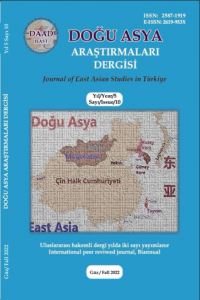Ekonomik Kalkınmadan Ekolojik Felaketlere: Çin’in Kuşak-Yol İnisiyatifinin Merkezi Asya’ya Olası Çevresel Etkileri
Bu çalışmanın amacı, Merkezi Asya’daki su sorunlarını Aral Gölü’nün çölleşme süreci üzerinden açıklamak, bunun yanında Çin’in girişimleriyle ortaya çıkan Kuşak Yol projesinin bölgedeki ekolojik sorunları daha da derinleştirme riski taşıdığını, Yeşil Teori’nin perspektifiyle ortaya koymaktır. Bu amaçla, çalışmanın ilk bölümünde Yeşil teori ve temel varsayımları üzerinde durulacaktır. Yeşil teorinin ekonomik ve siyasi olarak üzerinde durduğu temel prensipler açıklanarak, Merkezi Asya’daki çevre sorunlarının bu teorik perspektifle analiz edilmesinin önü açılacaktır. Ardından, Sovyetler Birliği’nin ekonomik büyümeyi amaçlayan devlet merkezli politikaları sonucunda Merkezi Asya’da ortaya çıkan ekolojik problemlere yer verilecektir. Çalışmanın son bölümünde ise, bir başka ekonomik büyüme ve devlet merkezli proje olan Çin’in Kuşak-Yol projesi temel prensipleriyle açıklanacak, projenin ekonomik büyümeyi sağlarken sebep olabileceği ekolojik felaketlere değinilecektir. Sonuç olarak, geçmişte Sovyetler Birliği’nin bölgenin ekolojik güvenliğine verdiği onarılması imkânsız tahribatın, günümüzde de Çin’in başrolünde olduğu bir ekonomik proje sonucunda tekrarlanabileceği sonucuna varılacaktır.
Anahtar Kelimeler:
Yeşil Teori, Aral Gölü, Su Sorunları, Kuşak-Yol Projesi, Çin
From Economic Development to Ecological Disaster: Possible Environmental Consequences of China’s Belt-Road İnitiative on Central Asia
The aim of this study is to analyze the draining of the Aral Sea and failed international cooperation efforts within the context of the Green Theory. Moreover, the study also aims to reveal that the Belt and the Road Initiative, led by China, can deepen the region's ecological problems in the upcoming years. For this purpose, Green Political Theory and its basic assumptions will be examined in the first chapter. Explaining the green theory's main pillars will help us understand Central Asia's environmental problems from an ecological perspective. Then, the reasons for the draining of the Aral Sea and the damaging effects of state-based policies will be set forth. In the following chapter, China's Belt-Road project, which is another economic growth and state-centered project, will be explained with its fundamental principles, and the ecological disasters that the project may cause will be mentioned. As a result, it will be concluded that the irreparable ecological damage inflicted by the Soviet Union can be replicated as a result of the Belt and the Road Initiative of China.
Keywords:
Aral Sea, Green Theory, Water Scarcity, BRI, China,
___
- AGAYEVA, Aygül (2017), Orta Asya’da Su Sorunu: Havzalar ve Barajlar, Uluslararası Afro-Avrasya Araştırmaları Dergisi Cilt 1, Sayı 3: 35-62.
- BENNİON, Polly ve diğerleri (2007), The Impact Of Airborne Dust On Respiratory Health in Children Living in the Aral Sea Region, International Journal of Epidemology, Sayı 36, Oxford University Press.
- CONCA, Ken ve ERİKA Weinthal (2016), The Oxford Handbook of Water Politics and Policy, Oxford University Press.
- DOBSON, Andrew (2008), Green Political Thought, Routledge, London.
- ECKERSLEY, Robyn (2013), Green Theory, International Relations Theories, Tim Dunne, Milja Kurki ve Steve Smith (ed.), Oxford University Press, Oxford.
- ELİZABETH Losos ve diğerleri (2019), Reducing Environmental Risks from Belt and Road Initiative Investments in Transportation Infrastructure, World Bank Group.
- GLANTZ, Michael H. (2007), Aral Sea Basin: A Sea Dies, a Sea Also Rises. AMBIO: A Journal of the Human Environment, Cilt 36, Sayı 4, 323-327.
- GALLAGHER, Kelly Sims & Qi Qi (2018), Policies Governing China’s Overseas Development Finance Implications for Climate Change, Boston.
- HOWARD, Ken W. F. ve Karina K. Howard (2016), The new ‘‘Silk Road Economic Belt’’ as a Threat to the Sustainable Management of Central Asia’s Transboundary Water Resources, Environ Earth Sci 75:844, 1-13.
- MEADOWS, Donella H. ve diğerleri (1972), The Limits To Growth; a Report for the Club of Rome's Project on the Predicament of Mankind, Universe Books, New York.
- MİCKLİN, Philip (2016), The future Aral Sea: hope and despair. Environ Earth Sci 75:844, 1-15.
- MİCKLİN, Philip (2010), The Past, Present, and Future of Aral Sea, Lakes & Reservoirs: Research and Management, Vol. 15.
- PARK, JeongWon Bourdais. ve Aigul Adibayeva (2020), Contestation and Collaboration for Water Resources: Comparing the Emerging Regional Water Governance of the Aral Sea, Irtysh River, and Mekong River, Journal of Asian and African Studies, 1-23.
- PATERSON, Mathew (2005), Green Politics, Theories of International Relations, S. Burchill ve A. Linklater (ed.), Green Politics, New York: Palgrave Macmillan.
- RAKHİMOV, Mirzokhid (2010), Internal and external dynamics of regional cooperation in Central Asia, Journal of Eurasian Studies, Vol. 1, 95-101.
- RİCHARDSON, Dick. ve Chris Rootes (1995), The Green Challenge, Routledge, New York.
- SORREL, Philippe (2006), The Aral Sea: A Palaeoclimate Archive, Doktora Tezi, Universität Potsdam
- WEİNTHAL, Erika (2002), State Making and Environmental Migration, The MIT Press. E-Kaynakça
- DW, https://www.dw.com/en/chinas-belt-and-road-is-green-and-clean-says-xi/a-48495226. Erişim, 11 Ocak 2021.
- President Xi Jinping Delivers Important Speech and Proposes to Build a Silk Road Economic Belt with Central Asian Countries, https://www.fmprc.gov.cn/mfa_ eng/topics_665678/xjpfwzysiesgjtfhshzzfh_665686/t1076334.shtml. Erişim, 01 Ocak 2021.
- United Nations, Global Issues, Water, https://www.un.org/en/sections/issues-depth/water/, Erişim, 03 Ocak 2021.
- ZHU, Shouqing ve SHA Song (2018), https://www.weforum.org/agenda/2018/09/three-ways-china-can-make-the-belt-and-road-initiative-sustainable/, Erişim, 01 Ocak 2021.
- China's Belt and Road is 'green and clean,' says Xi, https://www.dw.com/en/chinas-belt-and-road-is-green-and-clean-says-xi/a-48495226, Erişim, 05 Ocak 2021.
- ISSN: 2587-1919
- Yayın Aralığı: Yılda 2 Sayı
- Başlangıç: 2015
- Yayıncı: Abdürreşit Celil KARLUK
Sayıdaki Diğer Makaleler
Moğolların Güneydoğu Asya Devletleri ile Siyaseti
Turkish and Turkic Studies in Korea : Focusing on the Academic Institutions and Scholars in Korea
DENİZ GÜVENLİĞİ VE ÇİN ETKİSİ: ENDONEZYA'NIN GÜNEY ÇİN DENİZİ VE NATUNA ADALARI POLİTİKALARI
Vietnam’ın Çin ile İlişkileri: Aşk ve Nefret
Çin Siyasal ve Yönetim Sistemi Üzerine
